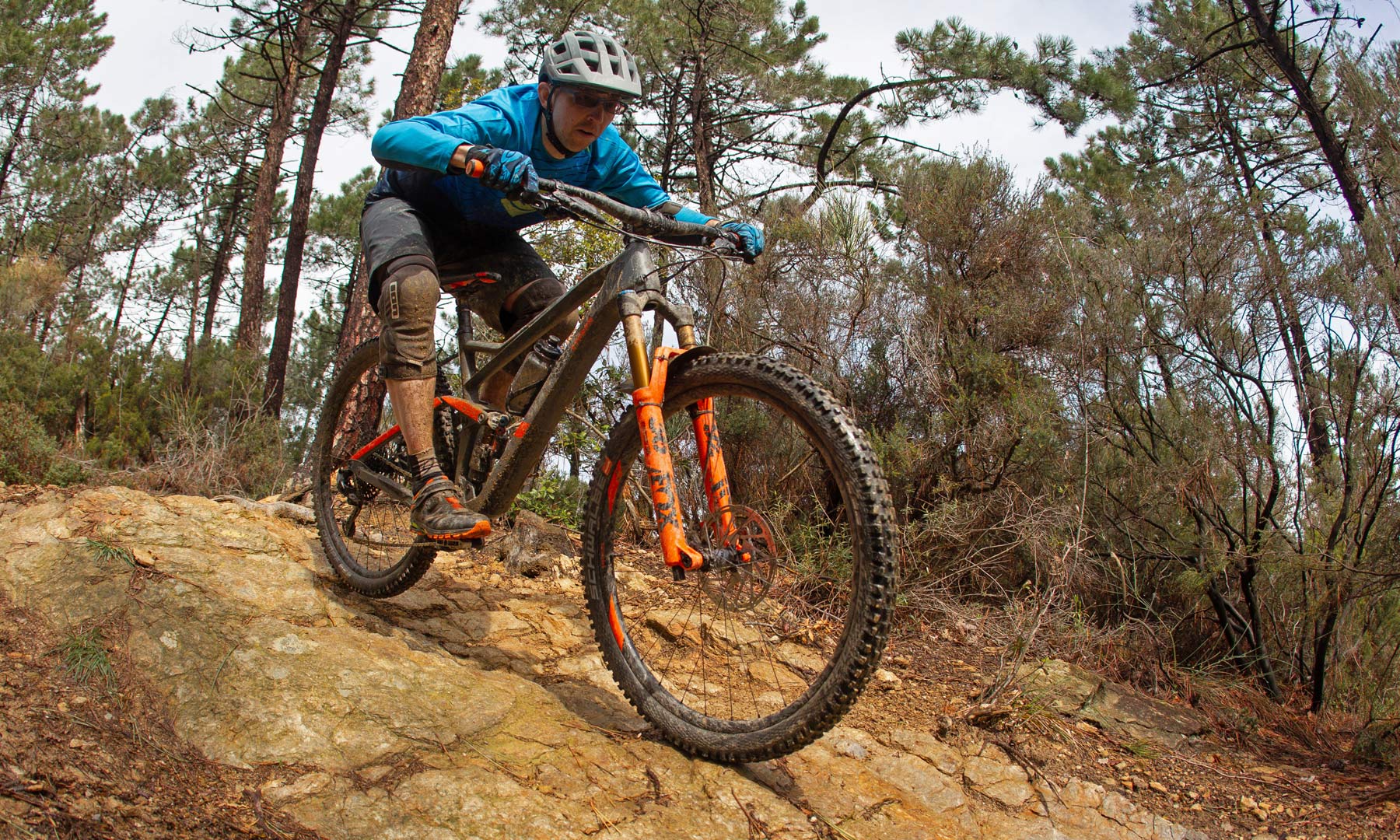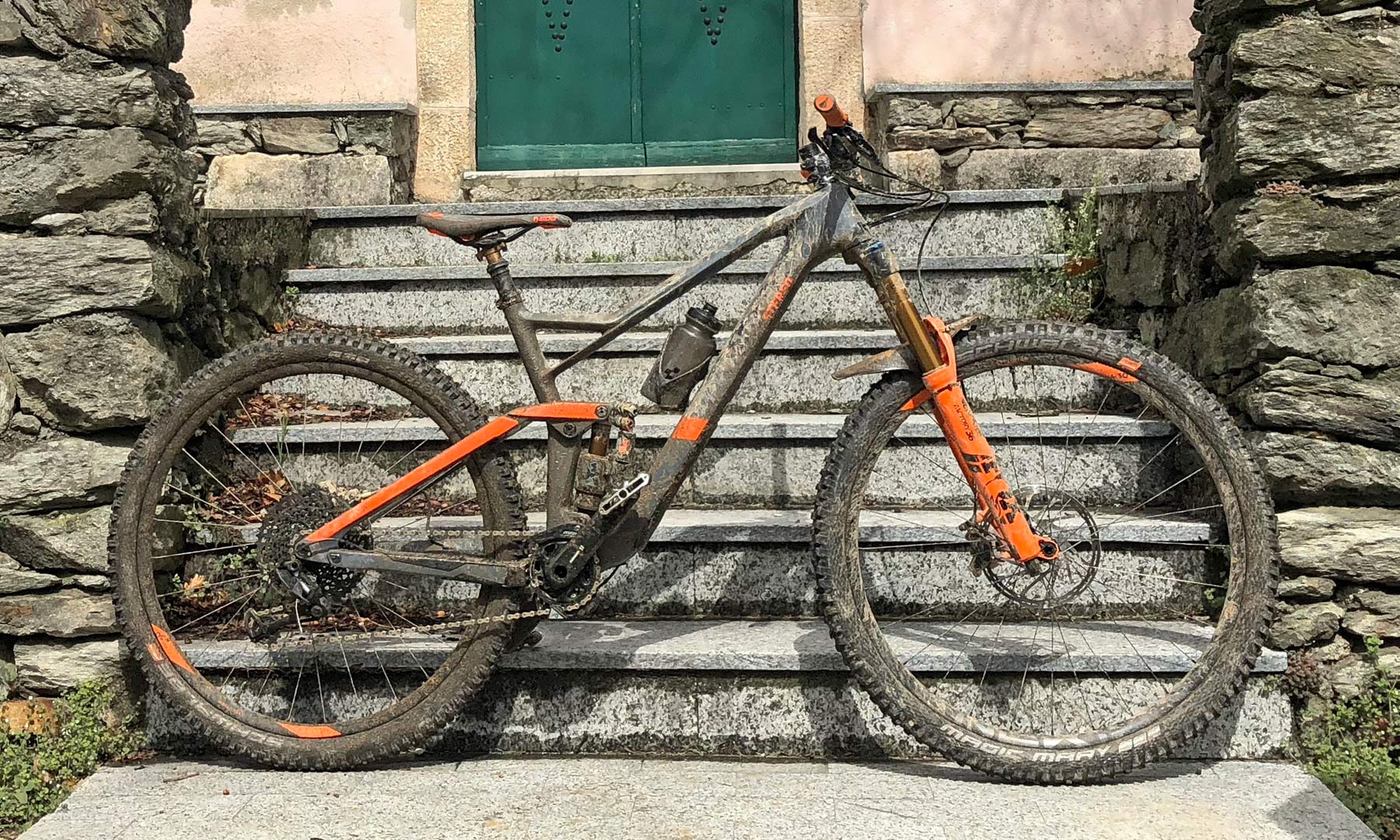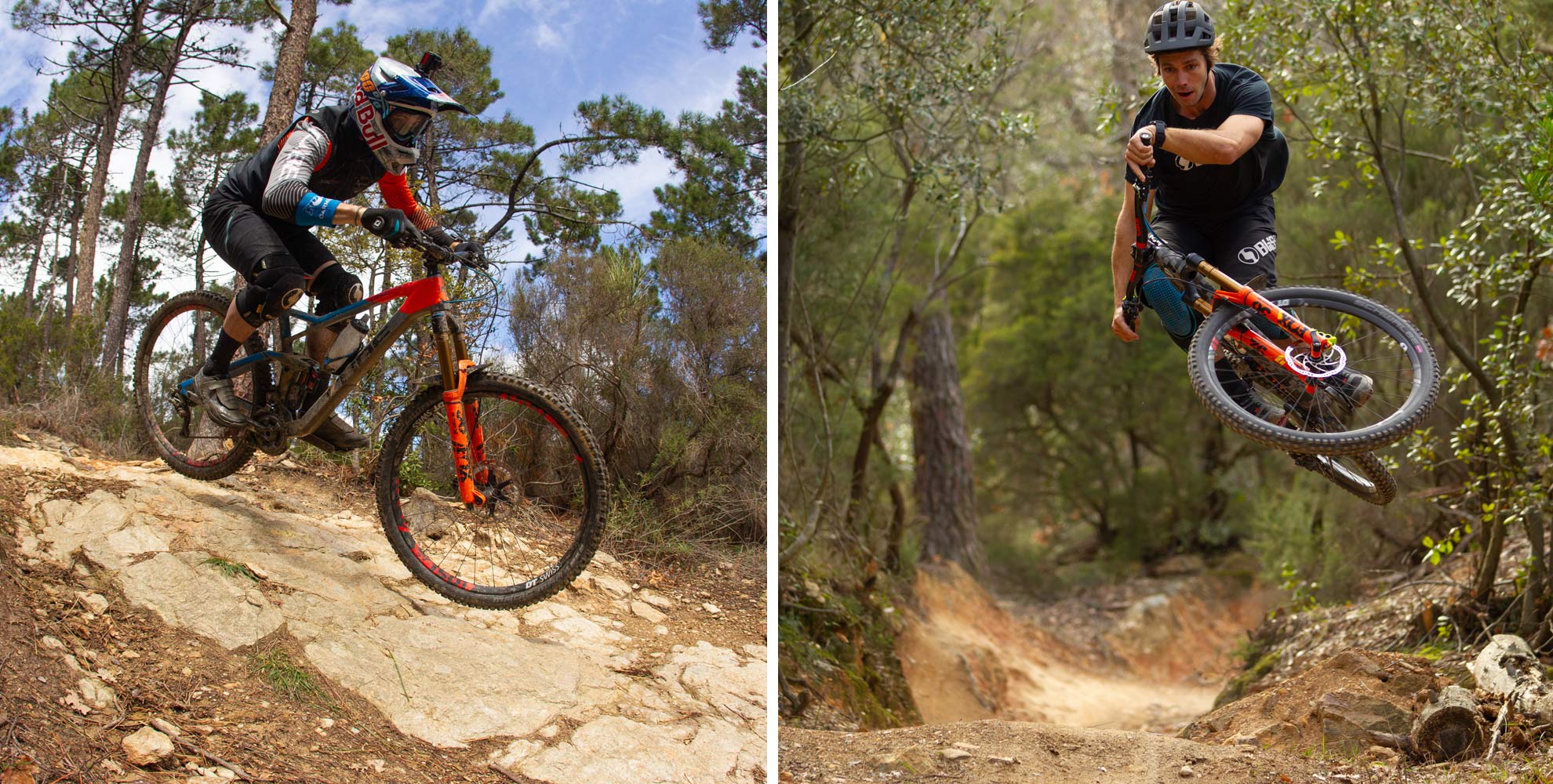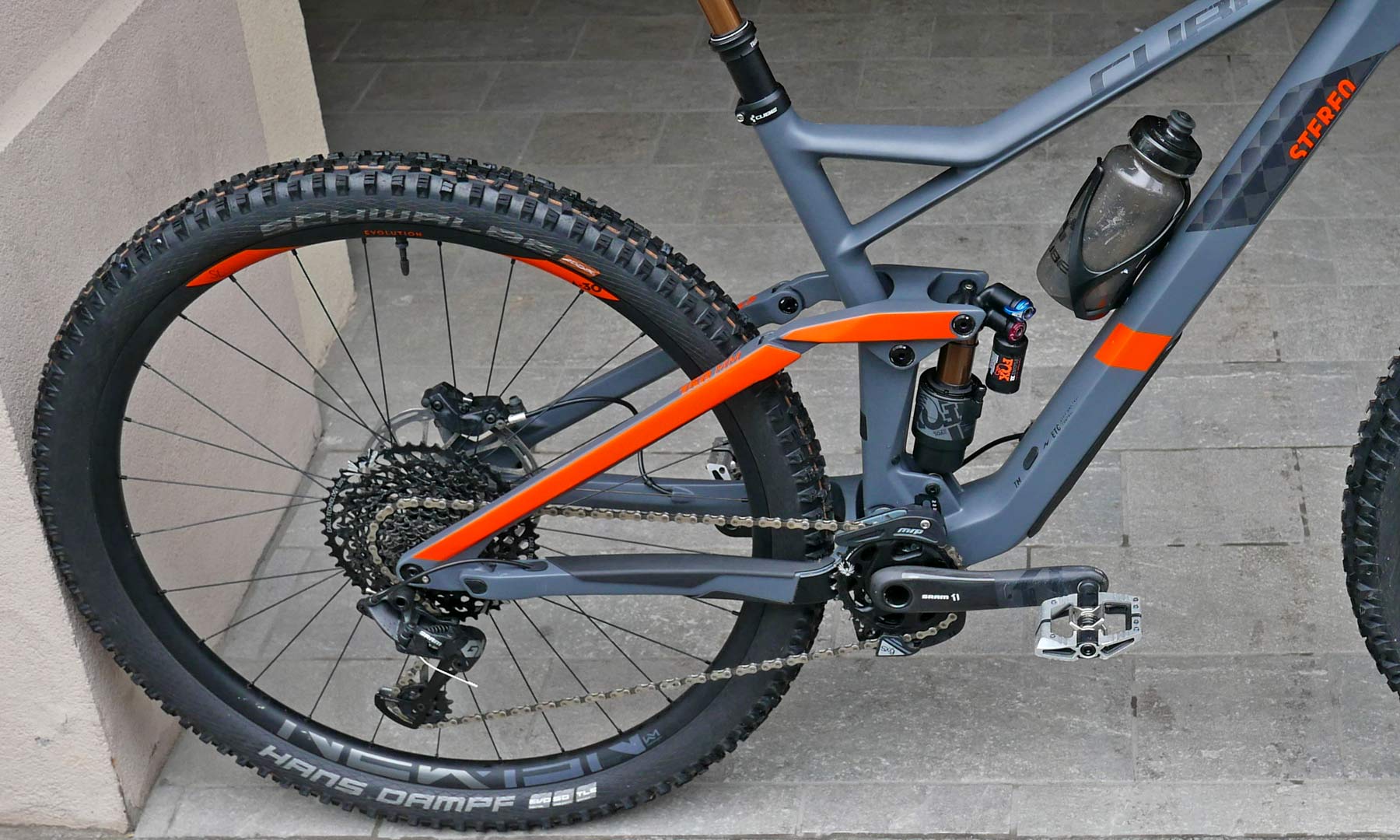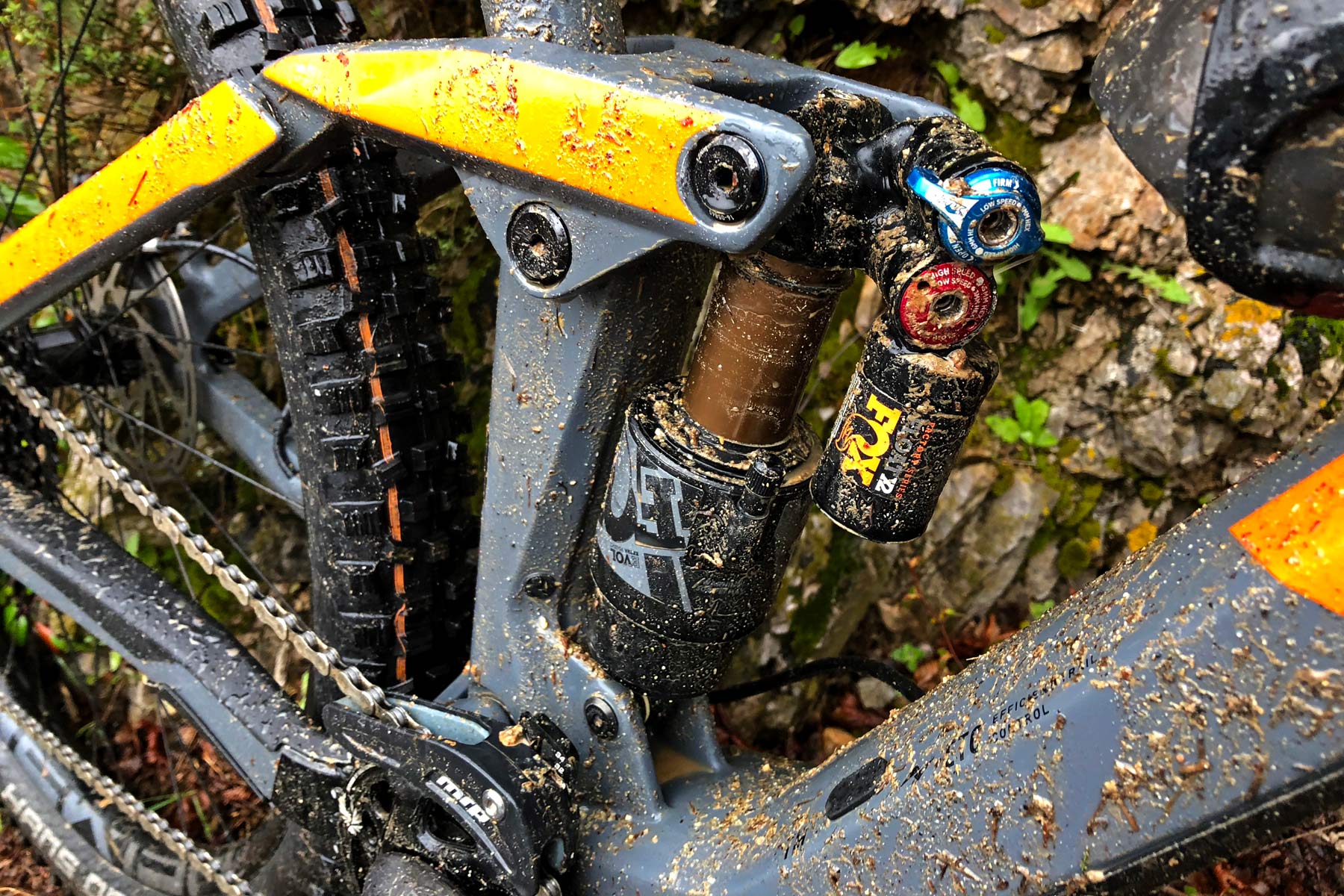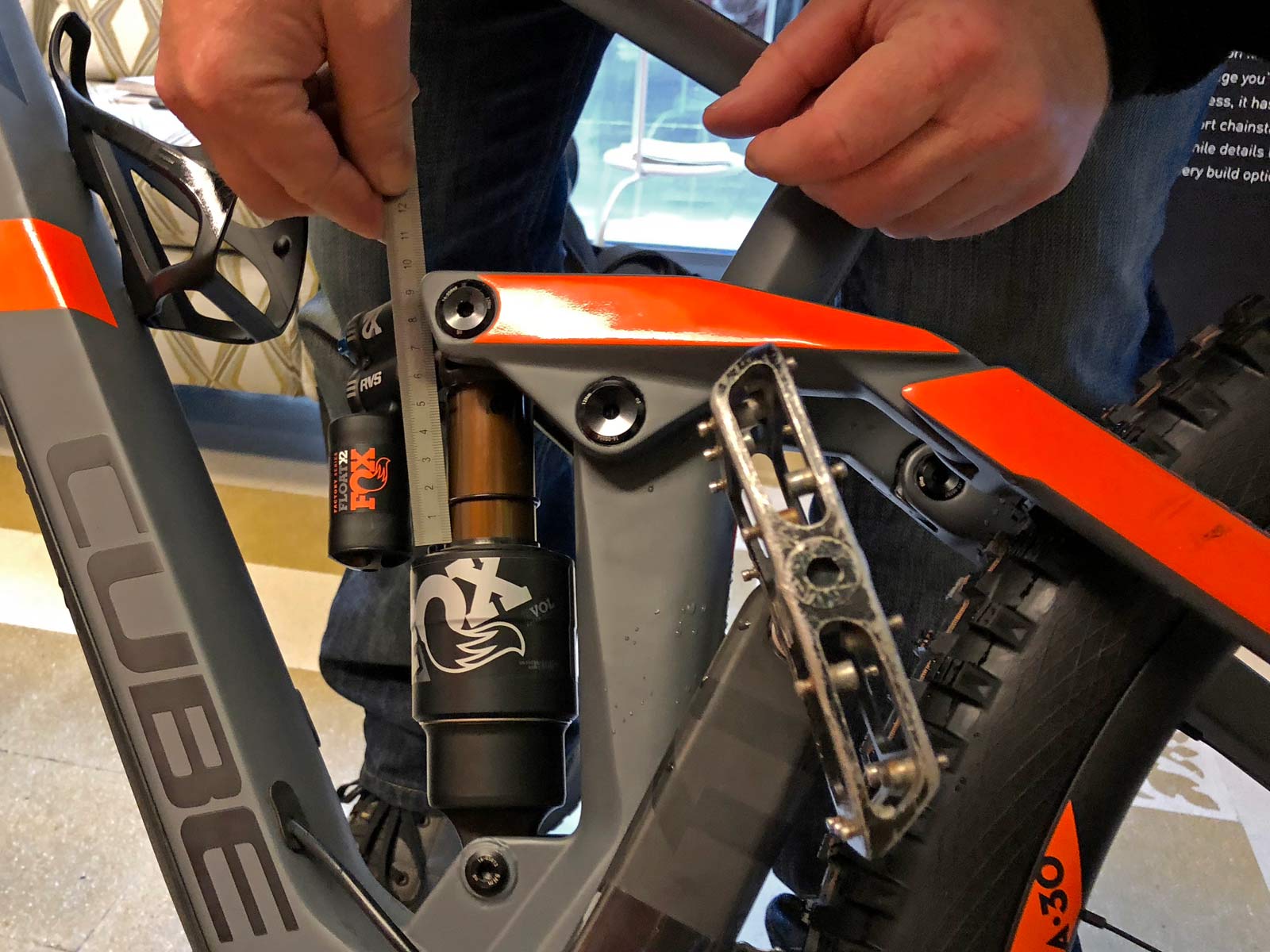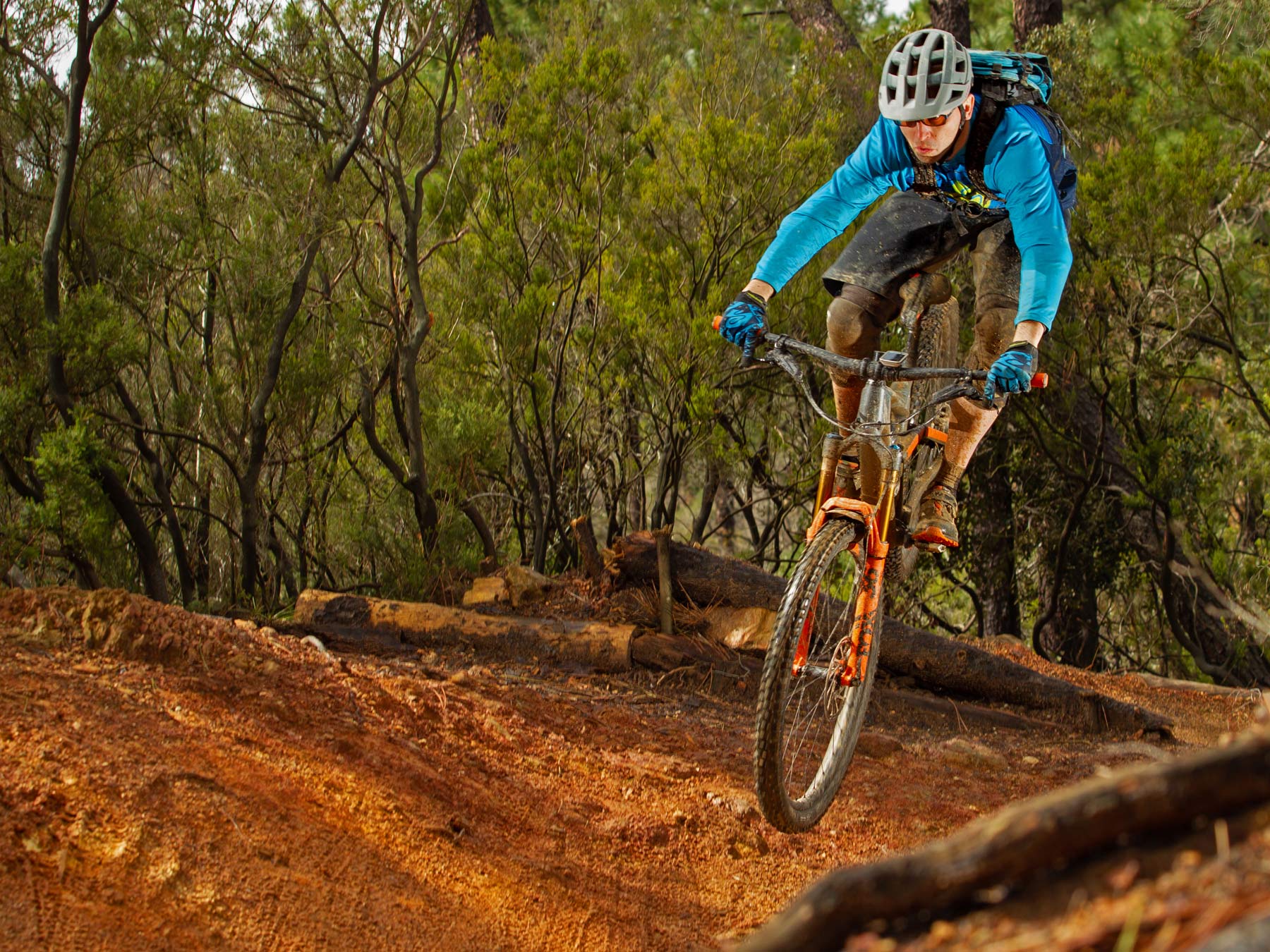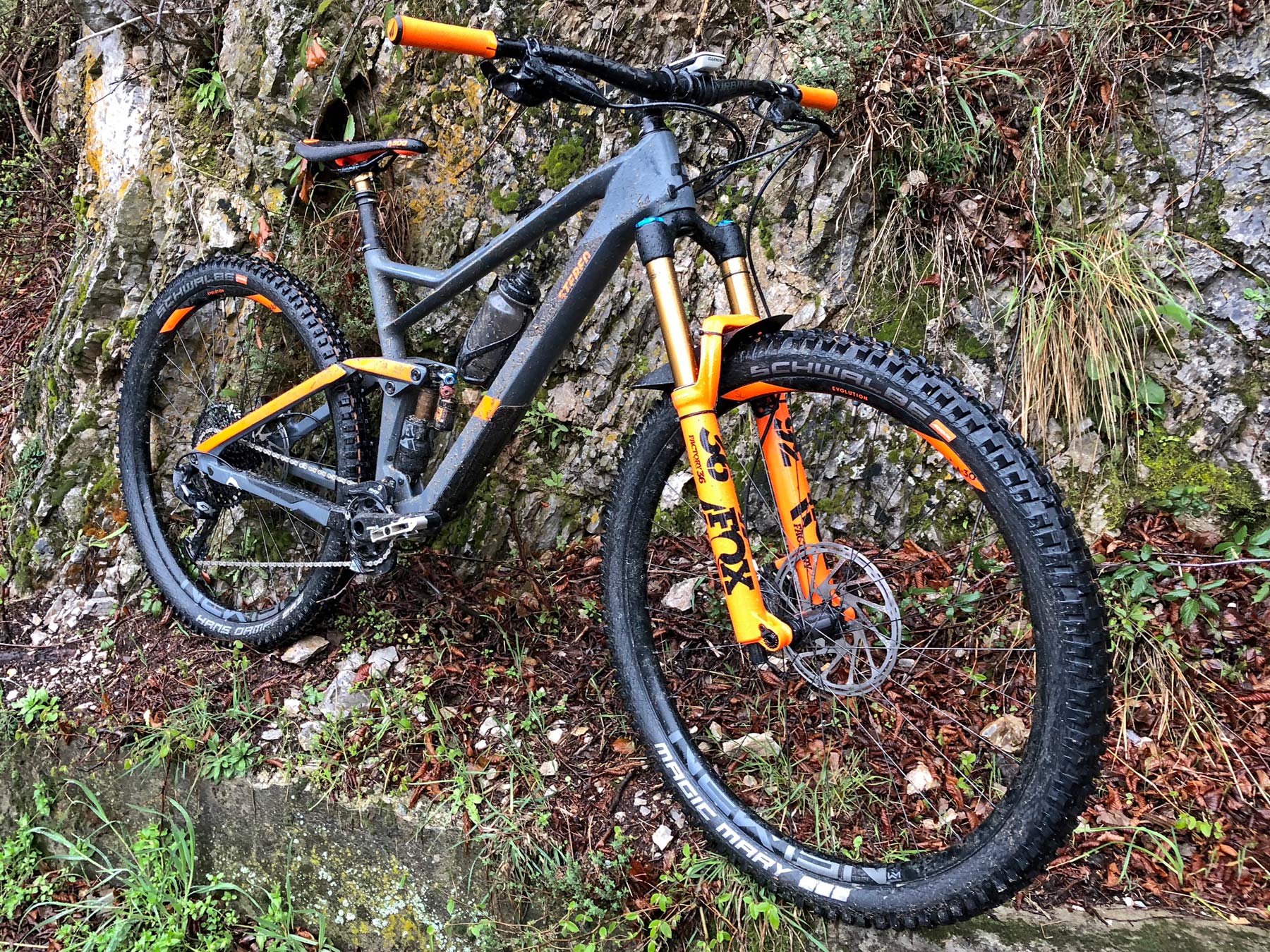Yesterday we detailed Cube’s move to 29″ wheels on the new Stereo 150 29, built for their Enduro World Series team. Previewing the surprisingly affordable carbon bike in Finale Ligure, we rode away impressed with the 29er’s agile & responsive ride on the technical terrain, chasing downhill after Cube’s pro riders.
Riding up and (mostly) down on the new Stereo 150 29
First raced in late 2017 at the Finale Ligure round of the EWS, we joined Cube and a couple of their pro riders who helped develop & race that prototype. Once again back in Finale, this time on unusually wet tracks, I spent a couple days bombing three distinctly different types of trails to test out the top-of-the-range, German-engineered Stereo 150 C:68 TM 29 (retailing for a race-ready reasonable 4500€.)
We started with wet, rocky & rooty singletrack with fast turns, tight switchbacks and drops that sneak up on you. Then came more wide open trails, slippery & loose with super rocky chutes that begged for as much speed at tire grip would allow. Lastly, we rounded it out with much steeper, more DH-like black diamond forest singletrack with big drops where gravity & momentum are your friends.
The little white rabbits I was chasing down the hill were Cube Action Team enduro pro Greg Callaghan (left) who was first at last year’s Madiera EWS round & third overall in the series, and Global Squad team DH racer Matt Walker (right) who won the Crankworx Rotorua Air DH competition last year and managed a second place at the Rotorua EWS stop. They provided some fun & air-infused line choices to follow, at least until I lost sight of them.
Key Tech Details
Spending time riding & chatting with these guys, as well as through detailed discussions with the product engineers who developed the bike, my biggest takeaway was probably that the ride feel & performance of the straight-forward, but well-optimized 150mm travel four-bar suspension design and 160mm fork travel is going to carry throughout the range.
The top is this TM model with the higher-grade C:68 carbon and gravity focused Kashima-coated Float X2 shock. But even the much more affordable 3200€ Race model still gets hi-mod C:62 carbon out of the same external mold and has Fox’s new for 2018 Float DPX2 that claims to be the “ultimate trail shock” blending X2 sensitivity & DPS cross-country efficiency at a Performance-level spec.
Other than hidden inside carbon layup that is said to shave off about 200g, and provide a marginal level of additional stiffness, all three of the new Stereo 150 29 frames share the same geometry and design tech features. Suspension spec level and component build are where the bikes differ. This TM test bike had Fox’s new Grip2 damper in its 36 Factory fork, offering all the adjustability you could ask for, including high & low speed control of both compression & rebound, plus a wider adjustment range, larger damper volume, and increased sensitivity with low friction seals.
The TM test bike also featured the new for 2018 large volume Fox Float X2 shock, with all the adjustability you could want, a beefed up air can, and a new internal bottom out bumper.
But the most important ride feature of the bike is probably the enduro race-ready geometry – slack 66° headtube, low 342mm bottom bracket height, and super short for enduro 435mm chainstays. Add to that a steep seat angle plus a dropper post to get you pedaling up hills.
The frame’s suspension pivots get varying attempts to conceal them. That’s really only an aesthetic choice, as they are still exposed to mud & debris thrown off the rear wheel. Bearings are used all around, and between standard labyrinth seals and Cube’s choice for packing the bearings fully with grease, they should stand up to the conditions. There a bunch of unused openings in the carbon frame to allow for many build & setup options, but Cube seems to do a pretty good job of plugging them. And I appreciated seeing drain holes molded into the bottom bracket.
Bike setup
We’ve talked a lot about suspension setup in our Suspension Tech series – from our latest look at using Apps to dial in settings, to the more comprehensive Suspension Setup Guide we compiled in the past. But looking at this bike, there are so many opportunities for easy external adjustment, before even thinking of more internal tuning with spacers and the like.
The Fox Float X2 Factory shock & Fox 36 Factory Grip2 fork have way more adjustability than I would have time to work out in a short couple days of testing. Lucky for me Cube’s chief Stereo suspension engineer and one of Fox’s race techs had been on hand dialing in the bikes for these trails over several days. They had already refined some ideal rebound & compression setting that allowed me to get the most out of the medium Stereo 150 C:68 TM 29 I was riding on these specific trails with just proper sag setup, and then needed very little adjustment to feel dialed out on the trail.
My settings for the fork – 88/78/75psi, HSC 14 clicks, LSC 10, HSR 7 & LSR 1 click. On the X2 on the 20″ frame – 225/245psi, HSC 16 clicks, LSC 18, HSR 14, LSR 10 & VS 2 clicks. Yeah that’s complicated, so good to have the pro support!
The other big individual bike setup variable is tire pressure. This bike build includes race-ready Schwalbe Addix orange Soft compound tires with Super Gravity casings set up tubeless. At 85kg ready to ride, I started with 20 psi in the 29×2.35″ Magic Mary front, and 22psi in the matching Hans Dampf rear. That’s just below their recommended range, but with the DH level sidewalls I still had plenty of support, and was clawing for grip in loose conditions. I actually tried a run with 3psi less, but felt like I lost stability, so returned to my starting point.
Riding Impressions – First Trail Tests
Riding the Stereo 150 29 through a wide range of steep & challenging terrain the single biggest take away was the bikes confidence-inspiring ride when the trail got rough. Riding a lot of 29ers through technical terrain, I am very familiar with big wheeled bikes rolling well through techy sections. But seldom am I as comfortable when the trail turns craxzy steep, literally disappears out from underneath me on a 29er. 150mm of travel isn’t a huge amount in the enduro sphere, but paired with the 160mm forks and 29″ wheels it felt like plenty even on what looked quite like a DH track.
The Stereo’s low bottom bracket and the shorter-than-my-hardatail chainstays seem to combine well with the falling leverage ratio suspension for a stable, connected-to-the-ground feel. The suspension did feel nearly bottomless, but unlike that photo of Matt up above (who clearly likes to air the bike out), I felt the Stereo 150 liked to stay planted to the ground – or maybe hovering just above the most technical sections.
It retains agile handling with the short rear end though all but the absolutely tightest switchbacks. But where I actually felt limited by the long, slack front end of the 29er was through tight turns when the trail wasn’t steep. The steeper switchbacks were fine as the bike is pointed downhill and I could really weight the front wheel, but I almost felt ground to a halt on flatter sections where the bike was slow to move through tight corners. It is a enduro race bike after all.
The bike’s forgiving race-capable feel going down, paired well with enough time spent pedaling to get a sense of the its climbing prowess. Those Soft Super Gravity tires certainly feel slow pedaling up. But popping the saddle up with the Fox dropper, and the Stereo 150 climbed reliably without bobbing. With downhill-ready rubber this bike would prefer to catch a shuttle for extended climbing, but steep and even pedal-heavy sections of trail were still fun to ride.
Final Thoughts
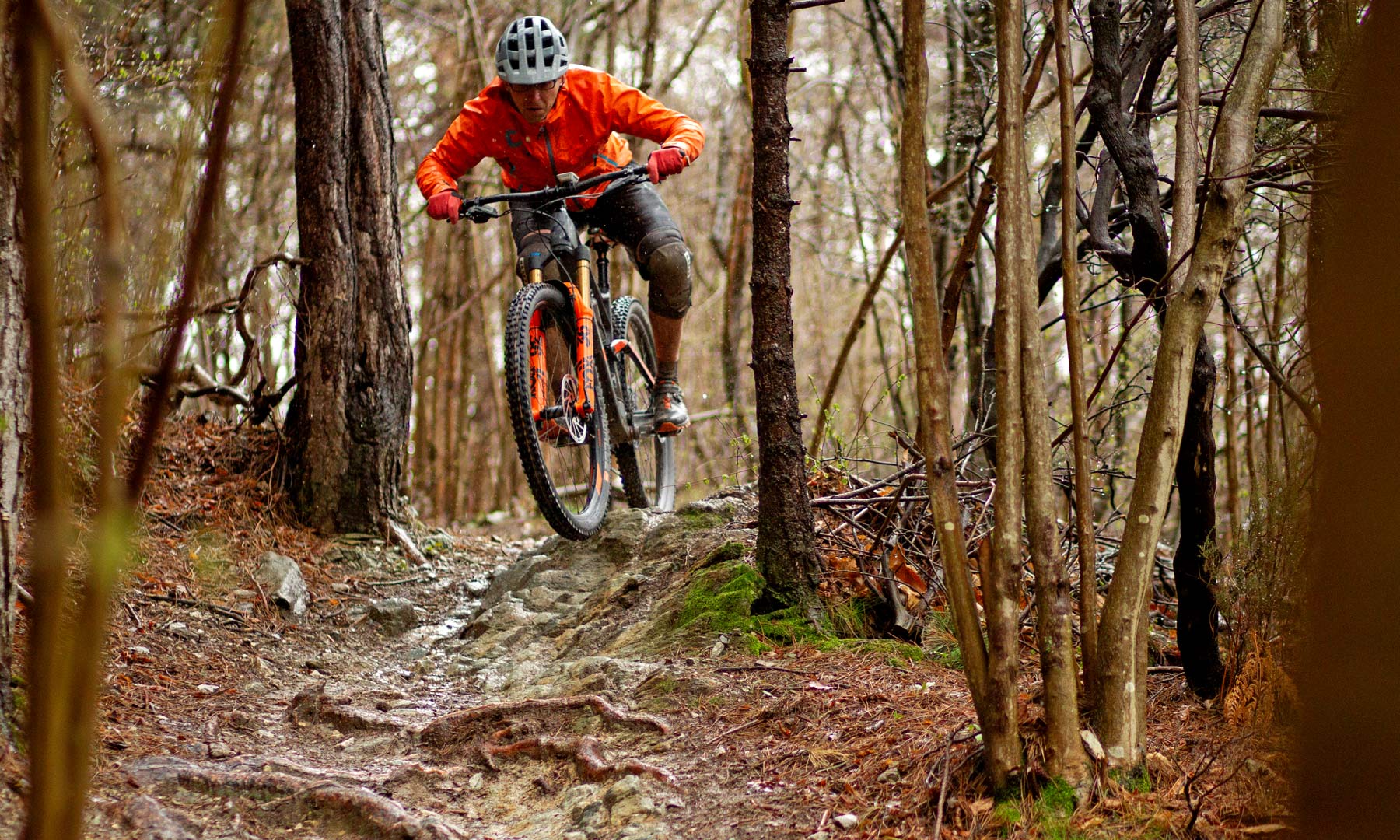
My final thoughts on the new Stereo 150 are that this is an incredibly fun, forgiving, and surprisingly affordable enduro bike. I may have been riding the 4500€ C:68 Team edition. But I think I would be just, if not more happy on the 3200€ Race version that uses a slightly heavier C:62 carbon construction and gets a full Shimano XT drivetrain (and more importantly XT brakes, which I prefer the feel of more). That build is by far the highest-value of the new bikes, and significantly cheaper than comparable builds I’ve been looking at for other 29er enduro bikes.
This TM version I rode is quoted at 13.9kg/30.6lb, while the Race build is actually said to be 300g lighter overall (bringing it under 30lb), likely thanks to lighter all-mountain tires. (Swap out the modular crank setup for an XT 1x and it would be lighter still.) I still wonder if I need so much travel in a big-wheeled bike, as I don’t always ride such steep trails. But a Stereo 150 29 would certainly be a blast, and would make my own mountain bike quiver a lot more gravity friendly.
